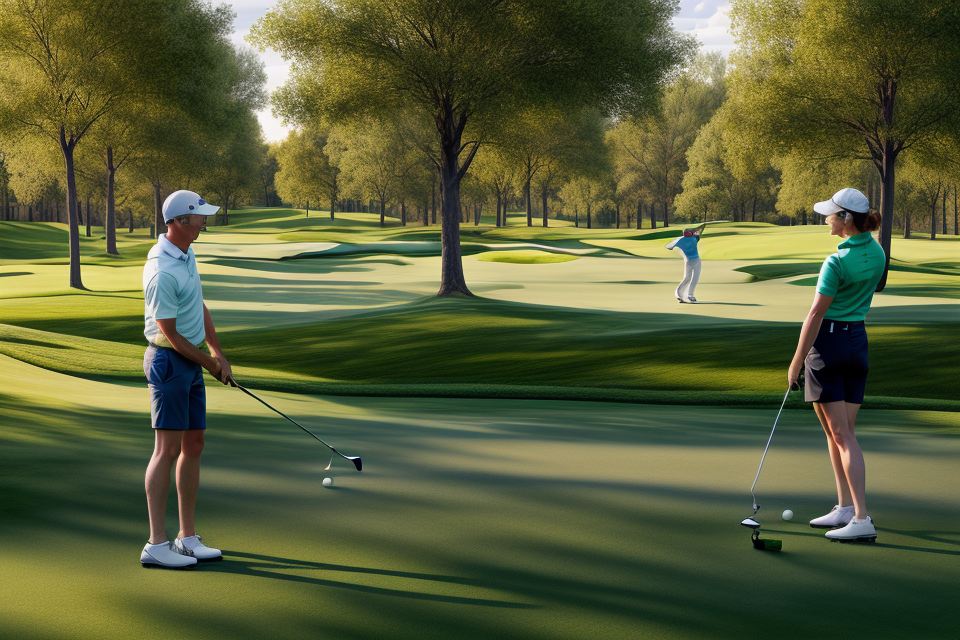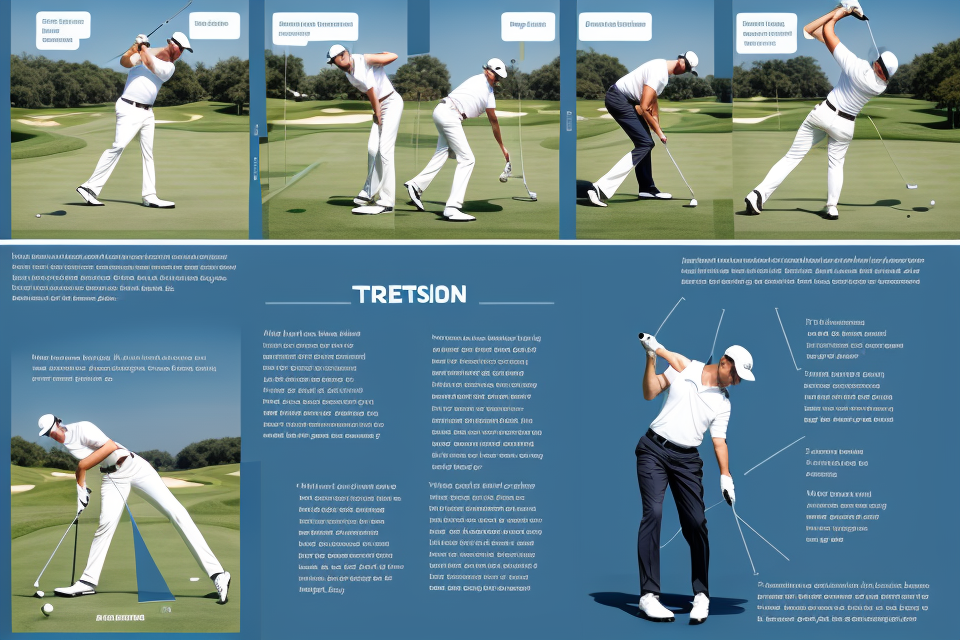
Golf is a sport that requires precision, patience, and practice. Mastering the golf swing is a crucial aspect of becoming a skilled golfer. However, for beginners, learning the golf swing can be a daunting task. It involves understanding the mechanics of the swing, developing the right muscle memory, and learning how to control your body movements. But with the right guidance and practice, anyone can learn to swing a golf club with confidence. In this comprehensive guide, we will explore the key elements of learning the golf swing for beginners, from the basics of grip and stance to the full swing motion. Whether you’re a complete novice or just looking to improve your swing, this guide will provide you with the tools and techniques you need to succeed on the golf course. So, let’s get started and take your first steps towards mastering the golf swing!
Understanding the Basics of Golf Swing
Golf Swing Anatomy
The Grip
The grip is the first point of contact between the golfer and the club. It is essential to have a strong and consistent grip to ensure that the club moves in the desired direction throughout the swing. A correct grip ensures that the clubface is square at address, which is crucial for hitting straight shots.
To achieve a correct grip, the golfer should place the hands on the club such that the palms are facing the target. The left hand should be placed on the grip with the fingers resting comfortably on the club’s bottom edge. The right hand should be placed on the grip with the thumb resting against the left hand’s fingers. The right pinky finger should be placed between the index and middle fingers of the left hand.
The Stance
The stance is the position of the golfer’s feet during the swing. It is crucial to have a stable and balanced stance to ensure that the golfer can make a smooth and powerful swing. A correct stance also ensures that the golfer can control the direction of the shot.
To achieve a correct stance, the golfer should stand with the feet shoulder-width apart. The left foot should be positioned slightly closer to the target than the right foot. The golfer should also bend the knees slightly to ensure that the lower body is flexible and can move freely during the swing.
The Setup
The setup is the position of the golfer’s body and club before the swing. It is essential to have a correct setup to ensure that the golfer can make a smooth and powerful swing. A correct setup also ensures that the golfer can control the direction of the shot.
To achieve a correct setup, the golfer should stand with the club resting on the ground behind the ball. The golfer should position the hands on the club such that the clubface is square to the target. The golfer should also position the feet shoulder-width apart and bend the knees slightly. The head should be positioned directly over the ball, and the eyes should be focused on the target.
The Golf Swing Kinematics
The Swing Plane
The swing plane refers to the imaginary path that the clubhead travels during the golf swing. It is essential to understand the swing plane to achieve a consistent and powerful golf swing. The swing plane can be visualized as a line that starts above the ball, moves down and behind the player, and then back up to the ball at impact. Maintaining the correct swing plane throughout the swing will help ensure that the clubhead is square to the target at impact, resulting in straighter shots.
The Swing Axis
The swing axis refers to the imaginary line that connects the ball to the target. It is important to keep the swing axis in mind when taking a golf swing to ensure that the ball is directed towards the target. The swing axis can be visualized as a line that starts at the ball, moves straight ahead, and ends at the target. To maintain the correct swing axis, players should aim their body, arms, and clubface at the target throughout the swing.
The Swing Circle
The swing circle refers to the circular motion of the clubhead during the golf swing. It is important to make a full, circular swing to generate power and accuracy. The swing circle can be visualized as a circle that starts above the ball, moves down and around the player, and then back up to the ball at impact. To make a full, circular swing, players should use their arms and shoulders to rotate their body and the clubhead around the swing circle.
Common Mistakes to Avoid
When learning how to golf swing, it is important to avoid certain common mistakes that can hinder progress and cause frustration. Here are some of the most common mistakes to watch out for:
Gripping the Club Too Tightly
One of the most common mistakes new golfers make is gripping the club too tightly. This can cause the hands to become tense and affect the accuracy and power of the shot. To avoid this mistake, it is important to grip the club with a relaxed and loose hand position.
Over-Swinging
Another common mistake is over-swinging, which can lead to a loss of control and accuracy. Over-swinging can cause the golfer to lose their balance and cause the ball to veer off course. To avoid this mistake, it is important to keep the swing smooth and controlled, focusing on making a full turn with the body and a smooth transfer of weight.
Lack of Practice
Finally, a lack of practice is one of the biggest obstacles to mastering the golf swing. It takes time and repetition to develop the muscle memory and technique needed to hit consistent shots. To avoid this mistake, it is important to dedicate time to practice regularly, focusing on the basics of the swing and gradually building up to more complex shots.
By avoiding these common mistakes, beginners can set themselves up for success and build a strong foundation for mastering the golf swing.
Developing a Solid Swing Mechanics
Warm-Up and Stretching Exercises
Before delving into the intricacies of the golf swing, it is essential to prepare the body for the physical demands of the game. Warm-up and stretching exercises are crucial in preventing injury and enhancing performance. In this section, we will discuss the importance of a pre-round warm-up and swing-specific stretching exercises.
Pre-Round Warm-Up
A pre-round warm-up is a series of exercises that are designed to prepare the body for the physical demands of the golf swing. It is recommended that golfers spend at least 10-15 minutes warming up before playing a round of golf. The warm-up should include a combination of dynamic stretches, such as arm circles and leg swings, and light aerobic activity, such as jogging or cycling.
Dynamic stretches are movements that involve active muscle contractions and releases. They help to increase blood flow to the muscles, improve flexibility, and enhance the body’s ability to generate power. Dynamic stretches should be performed slowly and controlled to avoid injury.
Light aerobic activity, such as jogging or cycling, helps to increase the heart rate and warm up the muscles. It also helps to improve the body’s overall cardiovascular fitness, which is essential for endurance during a round of golf.
Swing-Specific Stretching
Swing-specific stretching exercises are designed to target the muscles and joints used in the golf swing. These exercises help to improve flexibility, reduce the risk of injury, and enhance power and precision in the swing.
One example of a swing-specific stretching exercise is the hip flexor stretch. The hip flexors are a group of muscles located in the front of the hip that are responsible for flexing the hip joint. Tight hip flexors can lead to poor posture, decreased power, and an increased risk of injury. To perform the hip flexor stretch, stand with one foot on the ground and the other foot elevated on a bench or step. Lean forward into the stretch, keeping the back straight, until you feel a moderate stretch in the hip flexor. Hold the stretch for 15-30 seconds and repeat on the other side.
Another example of a swing-specific stretching exercise is the wrist and forearm stretch. The wrist and forearm muscles are used extensively in the golf swing to control the clubhead and generate power. To perform the wrist and forearm stretch, stand with one arm extended in front of the body with the palm facing down. Use the other hand to gently pull the fingers back toward the wrist until you feel a moderate stretch in the forearm and wrist. Hold the stretch for 15-30 seconds and repeat on the other side.
Incorporating a pre-round warm-up and swing-specific stretching exercises into your golf routine can help to improve your performance on the course and reduce the risk of injury. Remember to spend at least 10-15 minutes warming up before playing a round of golf and to include a combination of dynamic stretches and light aerobic activity. Additionally, incorporate swing-specific stretching exercises into your routine to improve flexibility and enhance power and precision in the swing.
The Most Important Muscles for a Good Golf Swing
The success of a golf swing largely depends on the synchronization of various muscles. Identifying the most important muscles can help beginners focus their training and improve their technique. Here are the key muscles to pay attention to:
- The Core: A strong core is crucial for a balanced and stable swing. The core muscles include the rectus abdominis, transversus abdominis, erector spinae, and obliques. These muscles help maintain posture, generate power, and control the transfer of energy from the lower body to the upper body during the swing.
- The Shoulders: The shoulders play a vital role in the golf swing, as they are responsible for generating speed and control. The rotator cuff muscles, including the supraspinatus, infraspinatus, teres minor, and subscapularis, help stabilize the shoulder joint and allow for a smooth motion. The deltoids, especially the anterior and posterior parts, are also essential for power and control.
- The Wrists: The wrists are involved in the control and direction of the clubhead during the swing. The muscles responsible for wrist flexion and extension are the flexor carpi radialis and extensor carpi radialis, respectively. The muscles that control wrist pronation and supination are the pronator teres and supinator. Maintaining a neutral wrist position throughout the swing can improve accuracy and power.
Improving Your Swing Through Drills
Mastering the golf swing requires a great deal of practice and repetition. While playing on the course is an excellent way to apply what you’ve learned, golf drills can help you refine your technique and build muscle memory. In this section, we’ll discuss the different types of drills that can help you improve your swing in various aspects of the game.
The Short Game Drills
The short game refers to shots taken within 100 yards of the green. Improving your short game can have a significant impact on your overall score. Some effective short game drills include:
- Chipping: Practice different types of chips, such as the bump-and-run and the pitch, to become proficient at getting the ball up and down from around the green.
- Pitching: Work on your pitching technique by focusing on a smooth, rhythmic motion that sends the ball toward the target.
- Sand play: If you struggle with bunker shots, spend time practicing different types of bunker shots, such as the explosion shot and the choke-down shot, to become more comfortable playing from sand.
The Full Swing Drills
Full swing drills focus on improving your technique for full shots, including drives and fairway woods. Some effective full swing drills include:
- Ball position: Practice different ball positions to learn how to adjust your setup for different shots.
- Swing tempo: Work on maintaining a consistent tempo throughout your swing to improve your accuracy and power.
- Shaft lean: Practice leaning the shaft forward during the downswing to promote a smooth, powerful transition.
The Putting Drills
Putting is a crucial aspect of the game, and improving your putting can greatly improve your overall score. Some effective putting drills include:
- Stroke technique: Practice different types of putting strokes, such as the conventional grip and the claw grip, to find what works best for you.
- Speed control: Work on controlling the speed of your putting strokes to become more consistent on the greens.
- Line control: Practice aligning your body and the putter correctly to improve your aim and accuracy.
In conclusion, golf drills are an essential part of mastering the golf swing. By practicing these different types of drills, you can improve your technique and build muscle memory, which will help you become a more consistent and confident golfer.
Using Technology to Improve Your Swing
TrackMan
TrackMan is a popular golf swing analysis tool that uses Doppler radar technology to measure various aspects of your swing. It can provide detailed data on ball flight, clubhead speed, spin rate, and trajectory, allowing you to identify areas for improvement. By using TrackMan, you can work on making adjustments to your swing that will help you hit the ball further and more accurately.
Swing Speed Radar
Swing Speed Radar is another tool that uses radar technology to measure clubhead speed. It can be used both on the driving range and on the golf course to help you monitor your swing speed and make adjustments as needed. By practicing with Swing Speed Radar, you can develop a faster and more consistent swing that will translate into longer drives and more accurate approach shots.
High-Speed Video Analysis
High-speed video analysis is a powerful tool that allows you to slow down and analyze your swing in slow motion. This can help you identify flaws in your technique and make corrections that will improve your swing mechanics. With high-speed video analysis, you can see exactly what’s happening in your swing, from the position of your hands at impact to the movement of your shoulders and hips. By using this technology, you can develop a more efficient and effective swing that will help you shoot lower scores.
The Role of Mental Game in Golf Swing
Golf is a game that requires not only physical skill but also mental strength. A strong mental game can help golfers stay focused, build confidence, and overcome obstacles during a round. In this section, we will explore the role of mental game in golf swing and discuss some techniques that can help beginners improve their mental toughness on the course.
Visualization Techniques
Visualization is a powerful tool that can help golfers improve their swing mechanics and mental focus. By visualizing the perfect swing in their mind, golfers can create a mental blueprint that they can refer to during a round. This technique involves closing your eyes and imagining yourself making a successful shot, paying attention to every detail, from the pre-shot routine to the follow-through. Visualization can help golfers build confidence, reduce anxiety, and improve their overall performance on the course.
Mindfulness and Meditation
Mindfulness and meditation are techniques that can help golfers develop a calm and focused mindset on the course. By practicing mindfulness, golfers can learn to stay present in the moment and avoid distractions that can disrupt their swing. Meditation can help golfers develop a clear and focused mind, allowing them to perform at their best when it matters most. These techniques can be practiced off the course and incorporated into a pre-round routine to help golfers prepare for a round of golf.
Building Confidence
Confidence is a crucial aspect of the mental game in golf. Golfers who believe in their ability to perform well on the course are more likely to perform at their best. Building confidence can be achieved through a combination of visualization, mindfulness, and meditation techniques, as well as through on-course experience. By focusing on past successes and positive outcomes, golfers can build confidence and reduce anxiety on the course. It’s important to remember that confidence is not something that can be achieved overnight, but rather it’s a result of consistent practice and dedication to improving one’s swing mechanics and mental toughness.
Implementing Your New Swing on the Course
Strategies for Playing Different Holes
As you begin to implement your new golf swing on the course, it’s important to consider different strategies for playing par 3s, par 4s, and par 5s. Here are some tips to help you navigate each type of hole:
Par 3s
- Pay attention to the wind: Par 3s are typically the shortest holes on the course, but the wind can have a significant impact on your shot. Take into account the direction and strength of the wind when choosing your club and aiming for the green.
- Be precise with your aim: Since par 3s are usually shorter, you’ll need to be more precise with your aim. Use the hazards and other features of the hole to help you gauge the correct distance and direction for your shot.
- Be prepared for different scenarios: Par 3s can be tricky, and you may encounter different scenarios depending on the hole layout. For example, some par 3s may have a large bunker guarding the green, while others may have a water hazard. Be prepared for any situation and plan your shot accordingly.
Par 4s
- Choose the right club: Par 4s require careful club selection to reach the green in regulation. Consider the distance of the hole, as well as any hazards or other features that could affect your shot.
- Manage your risk: Par 4s often require strategic decision-making to avoid hazards and other obstacles. Be aware of the risk/reward trade-offs on each hole and make a plan for managing your risk.
- Consider the pin position: The location of the flagstick can also impact your strategy on par 4s. If the pin is tucked behind a bunker or other hazard, you may need to aim for a different part of the green to avoid danger.
Par 5s
- Plan your shot strategy: Par 5s are longer holes that often require two shots to reach the green. Plan your shot strategy carefully, taking into account the hazards and other features of the hole.
- Manage your risk: Par 5s also require strategic decision-making to avoid hazards and other obstacles. Be aware of the risk/reward trade-offs on each hole and make a plan for managing your risk.
- Be prepared for different scenarios: Par 5s can be tricky, and you may encounter different scenarios depending on the hole layout. For example, some par 5s may have a narrow fairway, while others may have a large bunker guarding the green. Be prepared for any situation and plan your shot accordingly.
By using these strategies for playing different holes, you’ll be well on your way to mastering the golf swing and improving your game.
Managing Your Expectations
As you begin to implement your new golf swing on the course, it’s important to manage your expectations. Here are some tips to help you do just that:
- Remembering to Have Fun
It’s easy to get caught up in the pressure of performing well on the golf course, but it’s important to remember that golf is a game. Have fun and enjoy the experience of playing on the course. - Focusing on Progress, Not Perfection
It’s natural to want to improve your game as quickly as possible, but it’s important to remember that golf is a process. Focus on making progress, even if it’s small, rather than striving for perfection. - Being Patient with Yourself
Improving your golf swing takes time and patience. Be patient with yourself and don’t get discouraged if you don’t see immediate results. It’s important to give yourself time to make progress and learn from your mistakes.
Advancing Your Skills
As you continue to practice and refine your golf swing, it’s important to seek out opportunities to apply your new skills on the course. Here are some strategies for advancing your skills and continuing to improve:
- Joining a Golf League or Group: Playing golf with others can be a great way to practice your swing in a real-world setting. Golf leagues and groups provide a supportive environment for beginners to learn and improve their skills. Look for local leagues or groups, or consider joining an online community of golfers to connect with others and get feedback on your swing.
- Seeking Professional Help: Even as you become more confident in your swing, it’s important to continue seeking out professional help when needed. Golf instructors can provide personalized feedback and guidance on areas where you may be struggling, and can help you develop a customized practice routine to address your specific needs. Consider working with a certified instructor or golf coach to continue refining your skills.
- Continuing to Learn and Improve: Golf is a sport that requires ongoing learning and improvement. As you continue to play and practice, it’s important to stay curious and open to new ideas and techniques. Read golf magazines and blogs, watch instructional videos, and seek out feedback from other golfers to continue expanding your knowledge and skills. Remember that golf is a lifelong journey, and there is always more to learn and discover.
FAQs
1. What are the basic steps to learning the golf swing?
The basic steps to learning the golf swing include grip, stance, and posture. First, hold the golf club with a neutral grip, placing the hands on the club in a way that feels natural and comfortable. Next, set up to the ball with a comfortable stance, keeping your weight distributed evenly on both feet. Finally, maintain a proper posture, keeping your eyes on the ball and your spine straight throughout the swing.
2. How important is the grip on the golf club?
The grip on the golf club is very important, as it sets the foundation for the entire swing. A correct grip helps to maintain control of the club throughout the swing, while a poor grip can lead to a loss of control and inconsistent shots. To find the right grip, hold the club with a neutral grip, with the palms facing each other and the thumbs resting along the side of the shaft.
3. What is the correct posture for the golf swing?
The correct posture for the golf swing involves keeping your spine straight and your eyes on the ball. Stand with your feet shoulder-width apart, and bend your knees slightly to allow for a smooth, natural swing. Keep your spine straight and your shoulders relaxed, avoiding tension or over-rotation. Finally, keep your eyes on the ball throughout the swing, using it as a focal point to help you maintain a consistent, powerful swing.
4. How can I improve my swing speed?
To improve your swing speed, focus on making a full body rotation during the swing. Begin with a wide takeaway, using your arms and shoulders to bring the club back to the ball. As you approach impact, transfer your weight to your front foot and use your lower body to drive the club through the ball. Finally, finish with a full follow-through, using your arms and hands to bring the club to a complete stop after impact.
5. What are some common mistakes beginners make when learning the golf swing?
Common mistakes beginners make when learning the golf swing include using too much upper body in the swing, and not using the lower body enough. Additionally, many beginners struggle with maintaining a proper grip and posture, which can lead to inconsistent shots and lack of control. To avoid these mistakes, focus on keeping your spine straight, using your legs and hips to drive the swing, and maintaining a neutral grip on the club.


